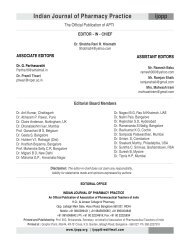Oct-Dec, 2011 - Indian Journal of Pharmacy Practice
Oct-Dec, 2011 - Indian Journal of Pharmacy Practice
Oct-Dec, 2011 - Indian Journal of Pharmacy Practice
- No tags were found...
Create successful ePaper yourself
Turn your PDF publications into a flip-book with our unique Google optimized e-Paper software.
Shobha C - Poison Information Center-An Overview <strong>of</strong> its Significance, Organization and FunctioningTraining <strong>of</strong> staff:Adequate training to PIC staff is essential especially for14,15newly recruited and inexperienced staff. PIC shoulddevelop and implement need based staff training manual. Thiswould enable the PIC to train the new and inexperienced staff<strong>of</strong> PIC in various areas and ensure that the uniformity in stafftraining is maintained. Training components may includeupdation <strong>of</strong> knowledge in clinical toxicology, communicationskills, handling <strong>of</strong> databases, retrieval <strong>of</strong> information,interpretation & analytical skills, handling <strong>of</strong> equipmentssuch as computers, telephones and other instruments.Handling <strong>of</strong> poison information query:The ultimate responsibility <strong>of</strong> the poison informationspecialist is handling the poison information query. To handlethe query, poison information specialist should have goodskills in communicating clearly and concisely to presentexplanatory or interpretive information. It is necessary toestablish and maintain effective working relationships withother employees <strong>of</strong> organisations and public in emergencyand other situations. Poison information specialist shouldadopt the skill <strong>of</strong> reacting calmly and effectively inemergency and stressful situation.Identifying those exposures that are potentially serious andrequire immediate medical assessment and those thatrepresent a minimal risk <strong>of</strong> toxicity can greatly aid in effectivemanagement <strong>of</strong> poisoning. By identifying exposures thatrepresent a minimal risk <strong>of</strong> toxicity, unnecessarypresentations to doctors and hospital emergency departmentscan be avoided. Poison information specialist must assesseach call carefully by listening to the caller and asking openendedquestions. Often the information provided by the calleris insufficient to give an accurate answer; in such cases furthertargeted questions should be asked. The poison informationspecialist taking the call must make a decision based on theinformation given by the caller, an assessment <strong>of</strong> thereliability <strong>of</strong> the history, their own clinical judgment and theinformation retrieved from the available sources. If anycomplicated query for which information is not available orthe enquirer is not satisfied with the information provided,then poison information specialist should contact/transfer thecall either to the manager/ director or consultant clinicaltoxicologist and seek their expert advice. Following are thesteps to approach poison information query.Step 1: Receive and obtain requester's demographics:Receive and accept the query related to the service either overphone or in person. Establish the identity <strong>of</strong> the enquirer bygathering contact details. Also obtain all required informationfrom requester that will help to reply the query. If the enquireris a healthcare pr<strong>of</strong>essional, the position and anticipatedknowledge <strong>of</strong> the enquirer should be determined. In caseswhere it takes time to obtain information, ask the enquirer tocall back or note their contact number. Query related topotentially serious poisoning cases need to be answeredimmediately and for a query with minimal toxicityappropriate deadline for a response should be established.Step 2: Collect background information:It is important to collect all the required backgroundinformation to provide appropriate information. Obtainingrelevant information <strong>of</strong>ten requires targeted questioning, andadditional care is necessary to accurately identify thepoisoning substance. However, all critical information shouldbe obtained in short time to maximize the patient outcome asotherwise it may be counter productive. Basic informationthat required to be obtained include age and/or weight <strong>of</strong>victim, substance/ product name, route <strong>of</strong> contact (ingestion,inhaled, dermal, ocular), quantity and/or strength involved,time since exposure, patient's condition (signs, symptomsetc.), treatment received and health status <strong>of</strong> patient includingmedication history, allergies, relevant pre-existingconditions.Step 3: Assessment <strong>of</strong> the condition:Appropriate background information allows in understandingthe actual query to be responded. Firstly, the urgency <strong>of</strong> thesituation is to be assessed in terms <strong>of</strong> whether the condition isan emergency, serious, not serious or no problem. Assess thelikelihood <strong>of</strong> toxicity associated with the exposed toxinsbased on the nature <strong>of</strong> substance, type <strong>of</strong> exposure andquantity consumed. Assessment <strong>of</strong> signs and symptoms <strong>of</strong>toxicity and analytical testing <strong>of</strong> compound may greatly aid indetermining the appropriate patient management whetherfirst aid, observation, medical treatment, home treatment orno treatment required for that particular condition.Step 4: Develop and conduct a search strategySelect and prioritise the information resources based onprobability <strong>of</strong> locating the desired information. It is ideal tolocate the information based on the probable efficiency <strong>of</strong>information sources in the literature hierarchy. Although inmany instances the information can be provided with the use<strong>of</strong> tertiary resource, it is worthwhile to consider the otherinformation sources as appropriate. Searching informationfrom databases like Poisindex, Hypertox and Intox mayenable the poison information specialist in retrieving thecomprehensive information in short time. In addition, use <strong>of</strong>developed poison management protocols may serve as aready reference especially in emergency situation. Theinformation resources used should be documented on thebasis <strong>of</strong> its usefulness in responding to a query.<strong>Indian</strong> <strong>Journal</strong> <strong>of</strong> <strong>Pharmacy</strong> <strong>Practice</strong> Volume 4 Issue 4 <strong>Oct</strong> - <strong>Dec</strong>, <strong>2011</strong> 18
















